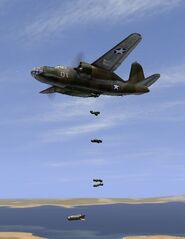| A-20 | |
|---|---|
 | |
|
Origin |
|
|
Introduction |
1941 |
|
Aliases |
Havoc |
|
Main users |
|
The Douglas A-20 began its life as Douglas Model 7 in 1936 to build an Twin-Engine Attack Bomber. The Design was not build to fulfill Request from USAAF but as Private Venture to sold the Aircraft to anyone / any parties who interested to purchase. The First order were placed by France in 1938, Ordered 100 Planes in total.
The French Requested a lot of Modifications, Resulting Douglas Model 7B which very different from the Initial Prototypes. Only 60 were delivered before The Fall of France to German Invasion in 1940. Most of Which did not see Combat, and Some of them Fly for the Vichy French Government. Some others remained in Free French until the end of War. The French had placed Additional Order of 60 DB-7s with Wright R-2600-A5B Engine, but none were delivered in time. Great Britain took over the Contract after Fall of France, and Redesigned it as Boston Mk.1 and Mk.2. By now, the DB-7 has Caught USAAF Attention who ordered the DB-7s for their use, now designated as A-20 Havoc.
The main shortcomings as British were concerned, was its short range. and The Boston Mk.3 variants were fitted a larger fuel tank, Redesigned Instrument Panels and Improved Hydraulic and Electrical systems. Looking to standardize their Havocs, the USAAF ordered what was essentially the Boston Mk.3 as A-20C. Many of the aircraft initially intended for British and Soviet use were kept by US After Pearl Harbor Attack. it was the most numerous pre-war variants, before the definitive variant, A-20G were introduced in 1943.
Notes for Il-2 Gameplay[]
Pilot Notes:
• The aircraft is equipped with a two-stage supercharger.
• Supercharger Stage 1 (default) should be used between 0 and 2,200 meters
• Supercharger Stage 2 should be used above 2,200 meters
• Mixture adjustment is automatic.
Using the Level Sight:
• The level bomb sight will automatically calculate the bomb trajectory and impact point based on the aircraft’s current airspeed and altitude. The bombardier must enter these parameters into the sight manually, and point it at the target. Then the sight will automatically track the target, and drop the bombs automatically at the right time.
• As the first step, bombing altitude and aircraft speed must be entered into the bombsight. The actual altitude above target (not above sea level) can be entered using the Increase Bombsight Altitude and Decrease Bombsight Altitude keys. The plane speed is entered using the Increase Bombsight Velocity and Decrease Bombsight Velocity keys. Note that the true (not indicated) airspeed must be set. It can be obtained from the speed gauge when in No-Cockpit View mode.
• After the initial parameters are entered, the bombardier has to acquire the target with the bombsight crosshair. Tap the Toggle Gunsight key (Shift-F1 by default) to look through the optics. Use Increase Bombsight Distance and Decrease Bombsight Distance to adjust the bombsight viewing angle up, and scan the horizon for the mission target.
• If the target does not appear along the centerline of the bomb sight optics, make minute changes to your plane’s course. Then using the Increase Bombsight Distance and Decrease Bombsight Distance keys place the crosshair on target. With the target dead center, turn on the targeting computer using the Toggle Bombsight Automation key. The bombsight will begin tracking the target. Correct the crosshair movement with the Increase Bombsight Velocity and Decrease Bombsight Velocity keys if necessary.
• The bombs will drop automatically when the plane reaches the proper position for a bomb drop, based on the input parameters and the optics angle.
• Note that after starting the bomb run, a plane may not be banked more than 4.5 degrees or the bombsight will lose stability. Only slight adjustments in direction are allowed. After more substantial maneuvers the bomb sight may take up to 30 seconds
Variants[]
- Douglas Model 7A : Initial Prototypes, powered by Pratt & Whitney 450hp R-985 Wasp Junior engines
- Douglas Model 7B : Redesigned Model 7A, Powered by 1100hp Pratt & Whitney R-1830-S3C3-G, 270 were ordered by French.
- DB-7B-3 : Redesigned for French Specifications, 1000hp Pratt & Whitney R-1830-SC3-G, Metric Instruments, French Guns
- Boston Mk.1 : French DB-7B with Pratt & Whitney R-1830-SC3-G Engines in British Service
- Boston Mk.2 : French DB-7B with Pratt & Whitney R-1830-S3C4-G Engines in British Service
- Havoc Mk.1 : Night Fighter / Night Bomber Conversion for Boston Mk.1 and Mk.2
- DB-7A : Built for French Spesifications, Powered by Wright R-2600-A5B Double Cyclone Engines
- DB-7B : Redesigned DB-7A with Improved Armor, Armament, and Range
- Boston Mk.3 : DB-7B in British Service
- DB-7C : Ordered by Netherlands, Cancelled due to Japanese Invasions, Shipment were Diverted to USSR
- A-20 : Initial USAAF Version. Similiar to DB-7B, Powered by Turbocharged Wright R-2600-7 Engines
- A-20B : DB-7A Modified for USAAF
- A-20C : Boston Mk.3 in USAAF Service
Specification (A-20C)[]
Engine:
2 x Wright R-2600-A5B, 1,600 HP
Armament:
• 6 x Browning .50 cal machine guns (forward-firing)
• 3 x Browning .50 cal machine guns (defensive)
• Up to 1,800 kg of bombs or Torpedoes
Advantages:
• Long range;
• Powerful armament by early-war standards.
Disadvantages:
• Poor defensive gun coverage.

